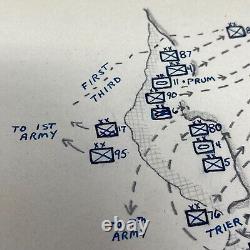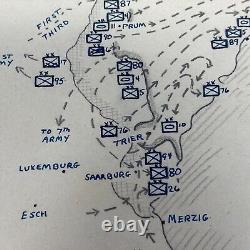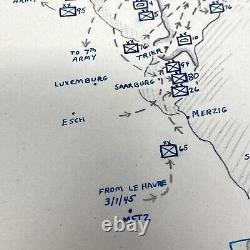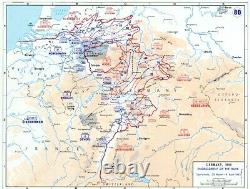RARE! WWII Pattons U. S. Third Army Hand-Drawn Western Allied invasion of German


















Comes with a hand-signed C. This extremely rare and museum-grade original WWII Pattons U. Third Army situation map is hand-drawn and shows a clear and simplified strategic view of the U. Third Army's movements from February 1st to March 13th. Situation maps like this were created using TOP SECRET and SECRET intelligence reports and front-line communications updates as the Allied forces pushed through France from the D-Day Normandy Beaches on June 6th, 1944. This situation was used by high-ranking officers of the U. Third Army and was used to make future strategic decisions during operations against Germans in France in 1944. Simplistic maps like this were hand-drawn to comprise more simplistic movement diagrams to see a more accurate picture of Division locations and movements on the front lines.
This situation map was preserved very well and remains in pristine condition given its age. This map shows the Western Allied invasion of Germany.
As Patton's 3rd Army was to drive east to. About 40 mi (64 km) southeast of Leipzig, but well short of the Elbe, and then turn southeast into.At the same time, General Devers' 6th U. Army Group would move south through.
Ending the threat of any German last-ditch stand there. The Western Allied invasion of Germany was coordinated by the Western Allies during the final months of hostilities in the European theatre of World War II.
In preparation for the Allied invasion of Germany east of the Rhine, a series of offensive operations were designed to seize and capture its east and west banks: Operation Veritable and Operation Grenade in February 1945, and Operation Lumberjack and Operation Undertone in March 1945; these are considered separate from the main invasion operation. The Allied invasion of Germany east of the Rhine started with the Western Allies crossing the river on 22 March 1945 before fanning out and overrunning all of western Germany from the Baltic in the north to the Alpine passes in the south, where they linked up with troops of the U. Combined with the capture of Berchtesgaden, any hope of German leadership continuing to wage war from a so-called "national redoubt" or escape through the Alps was crushed, shortly followed by unconditional German surrender on 8 May 1945. This is known as the Central Europe Campaign in United States military histories. By early 1945, events favored the Allied forces in Europe.On the Western Front, the Allies had been fighting in Germany with campaigns against the Siegfried Line since the Battle of Aachen, the Battle of Metz and the Battle of Hürtgen Forest in late 1944 and by January 1945, had pushed the Germans back to their starting points during the Battle of the Bulge. The failure of this offensive exhausted Germany's strategic reserve, leaving it ill-prepared to resist the final Allied campaigns in Europe. Additional losses in the Rhineland further weakened the German Army, leaving shattered remnants of units to defend the east bank of the Rhine. On 7 March, the Allies seized the intact bridge across the Rhine at Remagen, and established a large bridgehead on the river's east bank. During Operation Lumberjack, Operation Plunder and Operation Undertone, German casualties during February-March 1945 are estimated at 400,000 men, including 280,000 men captured as prisoners of war.
On the Eastern Front, the Soviet Red Army (including the Polish Armed Forces in the East under Soviet command), had taken most of Poland, launched an offensive into East Prussia and began their invasion into Eastern Germany in February 1945, and by March were within striking distance of Berlin. The initial advance into Romania, the First Jassy-Kishinev Offensive in April and May 1944 was a failure; the Second Jassy-Kishinev Offensive in August succeeded.The Red Army also pushed deep into Hungary (the Budapest Offensive) and eastern Czechoslovakia and temporarily halted at what is now the modern Germany-Poland border on the Oder-Neisse line. These rapid advances on the Eastern Front destroyed additional veteran German combat units and severely limited German Führer Adolf Hitler's ability to reinforce his Rhine defenses.
With the Soviets at the door of Berlin, the western Allies decided any attempt on their behalf to push that far east would be too costly, concentrating instead on mopping up resistance in the west German cities. Germany surrendered unconditionally on 8 May, leaving the western Allies in control of most of Germany.

